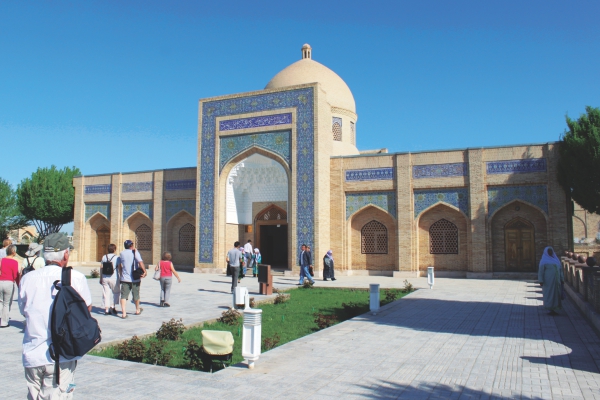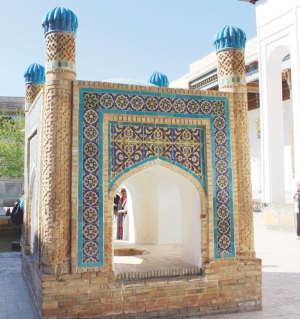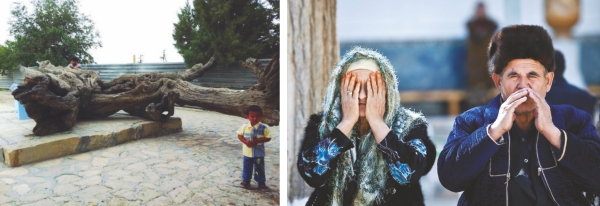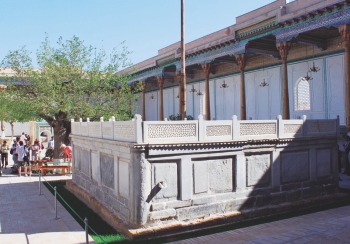| Home - Back Issues - The Team - Contact Us |
 |
| Volume 12 |Issue 09| March 01, 2013 | |
|
|
A Roman Column
BOKHARA 2 Tomb of the Design-Maker Sheikh Bahauddin Naqshbandi NEEMAN SOBHAN
Two different kinds of venues await us this second day in Bokhara: a place of veneration and spiritual peace; and a palace of earthly delights. Fazl, our tour guide is taking us first to the tomb of the Sufi teacher celebrated all over the Islamic world: Sheikh Bahauddin Naqshbandi (1318-1389). I decipher from the word 'Naqsh' or pattern that the name must have something to do with a family trade such as a Design-maker. “Engraver,” Fazl nods approvingly at my guess. What I did not know was that Sheikh Bahauddin's 'Naqshbandiyya' Order is notable because it is that rare one which traces its spiritual lineage/silsila from Prophet Mohammad (PBUH), linked through his childhood friend, the first Caliph, Hazrat Abu Bakr. We drive north and outside the town to the more recent and decorative mausoleum complex built around the humble grave of this holy man. We are first led to Sheikh Bahauddin's mother's tomb. The place and the shady grove around it is thronged with local visitors come to pray. As we walk towards the great Sufi's own tomb, Fazl tells us that he is respected as one of the few spiritual teachers who exhorted his followers the importance of being practical and of worldly service to fellow human beings. Apparently he counseled his spiritual adherents to not exaggerate the number of times they did the Hajj/pilgrimage to Mecca; instead, to use that money to help their poor neighbor or the impoverished in the community. We arrive at a rather arid garden leading to the mausoleum and find ourselves near a twisted and warped trunk of tree resembling a giant piece of drift wood. We are amused to see men, women and children trying to pass under the thick, low branches. Bits of cloth and ribbons are also flying from the higher stumps. Fazl explains that this is the tree, supposed to be of the same age as the Sheikh, attributed with magical properties such as granting longevity to those who touched it or walked around it thrice, and fulfilling the wishes of those who managed to pass under the low lying branches.
I stroked the almost petrified trunk and branches but made no wishes. Either I could think of nothing to wish for, or I could not decide which among my many wishes required immediate and providential intervention. After all, the fairytale trip to Samarkand and Bokhara had happened without my wishing it. So I continued to put my faith in the beauty of the inscrutable designs of the Grand Design Maker of all, before whom even the holiest of Naqshbands had to bow.
Most of the visitors at the tree and drifting with us inside the Mausoleum, we notice are locals. Many more are already inside the courtyard paying respect at the tomb. Devotional rituals and prayers at the tomb are discouraged, but many stand with bowed heads to imbue themselves with the blessings of a great soul. Architecturally, the place is not remarkable but it is the mystical atmosphere and the sense of a holy sanctuary where the presence and breath of a venerable life still seems to pervade that makes it a must-visit in the itinerary of most Muslim Tourists. What I like is the simplicity, the lack of ceremony or commercialism surrounding this place that is a holy shrine akin to that of Ajmer. Here there is little fuss or noise. We sit quietly in a shady place within the covered corridor surrounding the tomb and the four-pillared commemorative structure in the courtyard. A breeze shimmers among the leaves of the single tree in the paved courtyard. Peace brims to the core. Soon we are out and driving to the Summer Residence of the last Emir or Khan of Bokhara, called the Palace of Moon-like Stars: Sitorai-Mohki-Khasa. About that, next time.
|
||||||||
|



